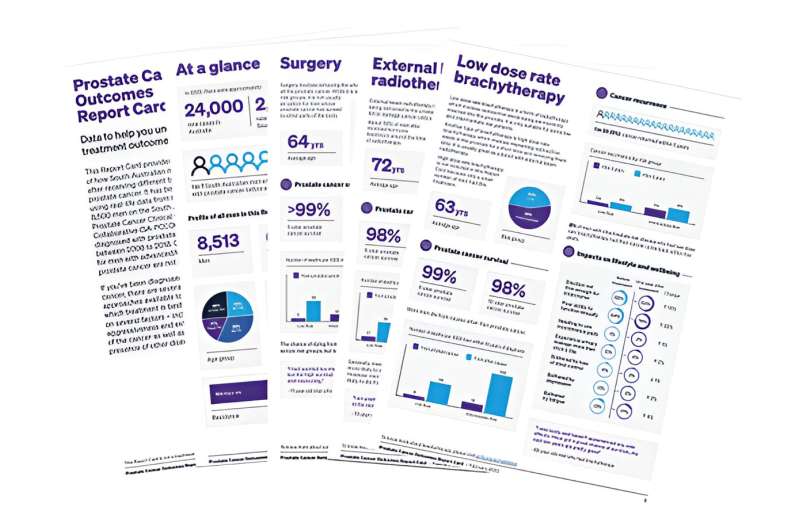This article has been reviewed according to Science X's editorial process and policies. Editors have highlighted the following attributes while ensuring the content's credibility:
fact-checked
trusted source
proofread
New prostate cancer resource keeps treatment options simple to understand

Every week, more than 400 men are diagnosed with prostate cancer. With treatment, survival rates for prostate cancer are high, but understanding the treatment options and side effects can be confusing.
Now, a new prostate cancer resource—the Prostate Cancer Outcomes Report Card—hopes to make it easier for men and their families to better understand the treatment options and outcomes.
Created by a team of South Australian cancer researchers and specialists and led by the University of South Australia's Dr. Kerri Beckmann, it breaks down different treatment types and evaluates survival rates, cancer recurrence, secondary treatments, and any impacts on urinary, bowel and sexual function.
Backed by research, the Report Card is based on real-life data from 8,513 South Australian men diagnosed with localized prostate cancer (2008–2018). It has been developed in collaboration with a consumer advisory group, interviews with men affected by prostate cancer, a survey among the general public, and feedback from clinicians.
A research paper associated with this work is published in the European Journal of Cancer Care.
UniSA researcher, Dr. Tenaw Tiruye, says the new Report Card delivers clear, easy-to-understand and tailored information so that prostate cancer patients can make informed decision about their care.
"There are various treatment options available for men diagnosed with prostate cancer, each of which can have significant side effects on men's physical functioning," Dr. Tiruye says.
"Patient preferences play a significant role in determining treatment choices, but often the available information is complex and overwhelming.
"Patients need access to reliable, comprehensive, simple, and up-to-date information about the potential risks and benefits of each treatment to reduce any unrealistic expectations about treatment outcomes and possible regret over their decisions.
"Providing easy-to-understand, accessible information in a single consumer-oriented report will help men better understand the treatment options and shared decision making between patients and clinicians.
"A consumer-focused approach to all aspects of prostate cancer care is essential."
Flinders Professor Michael O'Callaghan says the study, based on valuable data from the SA Prostate Cancer Clinical Outcomes Collaborative, will help "make better treatment decisions" in the future.
"This long-standing registry monitors how well people in SA fair after a diagnosis with prostate cancer," he says.
The research behind the Report Card found:
- A 97% five-year prostate cancer-specific survival rate.
- A secondary treatment after aggressive treatments (surgery and radiotherapies) is not uncommon as there is a reasonably high chance of cancer returning.
- One in three men who opted for active surveillance (recommended for men with low-risk prostate cancer) went on to have other treatments within five years.
- Men who underwent surgery often experienced a significant decrease in urinary continence and sexual function.
- Men who received external beam radiation therapy had the greatest decline in bowel function.
- men who received hormone therapies experienced increases in hot flashes, changes in body weight and depression.
- A higher risk level at the time of diagnosis was associated with a worse prognosis, a higher chance of recurrence, faster transition to active treatment, and greater decline in quality of life.
More information: Tenaw Tiruye et al, Reporting Real-World Data on Prostate Cancer Treatment Outcomes to Consumers: The Prostate Cancer Report Card, European Journal of Cancer Care (2023). DOI: 10.1155/2023/6660371

















